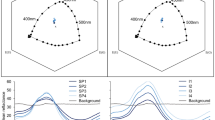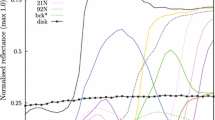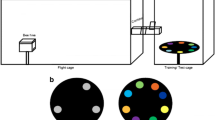Abstract
Differences in the concentration of pigments as well as their composition and spatial arrangement cause intraspecific variation in the spectral signature of flowers. Known colour preferences and requirements for flower-constant foraging bees predict different responses to colour variability. In experimental settings, we simulated small variations of unicoloured petals and variations in the spatial arrangement of colours within tricoloured petals using artificial flowers and studied their impact on the colour choices of bumblebees and honeybees. Workers were trained to artificial flowers of a given colour and then given the simultaneous choice between three test colours: either the training colour, one colour of lower and one of higher spectral purity, or the training colour, one colour of lower and one of higher dominant wavelength; in all cases the perceptual contrast between the training colour and the additional test colours was similarly small. Bees preferred artificial test flowers which resembled the training colour with the exception that they preferred test colours with higher spectral purity over trained colours. Testing the behaviour of bees at artificial flowers displaying a centripetal or centrifugal arrangement of three equally sized colours with small differences in spectral purity, bees did not prefer any type of artificial flowers, but preferentially choose the most spectrally pure area for the first antenna contact at both types of artificial flowers. Our results indicate that innate preferences for flower colours of high spectral purity in pollinators might exert selective pressure on the evolution of flower colours.





Similar content being viewed by others
References
Armbruster WS, Antonsen L, Pélabon C (2005) Phenotypic selection on Dalechampia-blossoms: honest signaling affects pollination success. Ecology 86:3323–3333
Asmussen CB (1993) Pollination biology of the Sea Pea, Lathyrus japonicus: floral characters and activity and flight patterns of bumblebees. Flora 188:227–237
Backhaus W (1991) Color opponent coding in the visual system of the honeybee. Vis Res 31:1381–1397
Belsare PV, Sriram B, Watve MG (2009) The co-optimization of floral display and nectar reward. J Biosci 34:963–967
Brandt R, Vorobyev M (1997) Metric analysis of threshold spectral sensitivity in the honeybee. Vis Res 37:425–439
Chittka L (1992) The colour hexagon: a chromacity diagram based on photoreceptor excitations as a generalized representation of colour opponency. J Comp Physiol A 170:533–545
Chittka L (1999) Bees, white flowers, and the color hexagon—a reassessment? No, not yet. Naturwissenschaften 86:595–597
Chittka L, Kevan PG (2005) Flower colour as advertisement. In: Dafni A, Kevan PG, Husband BC (eds) Practical pollination biology. Enviroquest Ltd., Cambridge
Chittka L, Menzel R (1992) The evolutionary adaptation of flower colours and the insect pollinators’ colour vision. J Comp Physiol A 171:171–181
Chittka L, Raine NE (2006) Recognition of flowers by pollinators. Curr Opin Plant Biol 9:428–435
Chittka L, Thomson JD, Waser NM (1999) Flower constancy, insect psychology, and plant evolution. Naturwissenschaften 86:361–377
Dafni A, Lehrer M, Kevan PG (1997) Spatial flower parameters and insects spatial vision. Biol Rev 72:239–382
Dafni A, Kevan PG, Husband BC (2005) Practical pollination biology. Enviroquest Ltd, Cambridge
Daumer K (1956) Reizmetrische Untersuchungen des Farbensehens der Bienen. Z Vergl Physiol 38:413–478
de Brito Sanchez MG, Ortigao-Farias J, Gauthier M, Liu F, Giurfa M (2007) Taste perception in honeybees: just a taste of honey. Arthropod Plant Interact 1:69–76
Dobson HEM, Danielson EM, Wesep IDV (1999) Pollen odor chemicals as modulators of bumble bee foraging on Rosa rugosa Thunb. (Rosaceae). Plant Spec Biol 14:153–166
Dyer AG (2006) Bee discrimination of flower colours in natural settings. Entomol Gener 28:257–268
Dyer AG, Chittka L (2004a) Fine colour discrimination requires differential conditioning in bumblebees. Naturwissenschaften 91:224–227
Dyer AG, Chittka L (2004b) Biological significance of distinguishing between similar colours in spectrally variable illumination: bumblebees (Bombus terrestris) as a case study. J Comp Physiol A 190:105–114
Dyer AG, Murphy AH (2009) Honeybees choose “incorrect” colors that are similar to target flowers in preference to novel colors. Isr J Plant Sci 57:203–210
Dyer AG, Neumeyer C (2005) Simultaneous and successive colour discrimination in the honeybee (Apis mellifera). J Comp Physiol A 191:547–557
Dyer AG, Whitney HM, Arnold SEJ, Glover BJ, Chittka L (2007) Mutations perturbing petal cell shape and anthocyanin synthesis influence bumblebee perception of Antirrhinum majus flower colour. Isr J Plant Sci 57:203–210
Dyer AG, Spaethe J, Prack S (2008) Comparative psychophysics of bumblebee and honeybee colour discrimination and object detection. J Comp Physiol A 194:617–627
Dyer AG, Boyd-Gerny S, McLoughlin S, Rosa MGP, Simonov V, Wong BBM (2012) Parallel evolution of angiosperm colour signals: common evolutionary pressures linked to hymenopteran vision. Proc R Soc B 279:3606–3615
Giurfa M, Núñez J (1989) Colour signals and choice behavior of the honeybee (Apis mellifera ligustica). J Insect Physiol 35:907–910
Giurfa M, Núñez J, Chittka L, Menzel R (1995) Colour preferences of flower-naive honeybees. J Comp Physiol A 177:247–259
Giurfa M, Vorobyev M, Kevan P, Menzel R (1996) Detection of coloured stimuli by honeybees: minimum visual angles and receptor specific contrast. J Comp Physiol A 178:699–709
Giurfa M, Vorobyev M, Brandt R, Posner B, Menzel R (1997) Discrimination of coloured stimuli by honeybees: alternative use of achromatic and chromatic signals. J Comp Physiol A 180:235–243
Goulson D, Cruise JL, Sparrow KR, Harris AJ, Park KJ, Tinsley MC, Gilburn AS (2007) Choosing rewarding flowers; perceptual limitations and innate preferences influence decision making in bumblebees and honeybees. Behav Ecol Sociobiol 61:1523–1529
Gumbert A (2000) Color choice by bumble bees (Bombus terrestris): innate preferences and generalization after learning. Behav Ecol Sociobiol 48:36–43
Hempel de Ibarra N, Vorobyev M, Brandt R, Giurfa M (2000) Detection of bright and dim colours by honeybees. J Exp Biol 203:3289–3298
Hempel de Ibarra N, Giurfa M, Vorobyev M (2001) Detection of coloured patterns by honeybees through chromatic and achromatic cues. J Comp Physiol A 187:215–224
Heuschen B, Gumbert A, Lunau K (2005) A generalised mimicry system involving angiosperm flower colour, pollen and bumblebees’ innate colour preferences. Plant Syst Evol 252:121–137
Ilse D (1949) Colour discrimination in the dronefly, Eristalis tenax. Nature 163:255–256
Kelber A, Osorio D (2010) From spectral information to animal colour vision: experiments and concepts. Proc R Soc Lond B 277:1617–1625
Kelber A, Balkenius A, Warrant EJ (2002) Scotopic colour vision in nocturnal hawkmoths. Nature 419:922–925
Kevan PG, Lane MA (1985) Flower petal microtexture is a tactile cue for bees. Proc Natl Acad Sci USA 82:4750–4752
Kugler H (1935) Blütenökologische Untersuchungen mit Hummeln. VII. Die Anlockung von „Neulingen” durch Blüten. Planta 23:692–714
Lehrer M (1999) Dorsoventral asymmetry of colour discrimination in bees. J Comp Physiol A 184:195–206
Lehrer M, Bischof S (1995) Detection of model flowers by honeybees: the role of chromatic and achromatic contrast. Naturwissenschaften 82:145–147
Leonard AS, Dornhaus A, Papaj DR (2011) Flowers help bees cope with uncertainty: signal detection and the function of floral complexity. J Exp Biol 214:113–121
Lunau K (1990) Color saturation triggers innate reactions to flower signals—flower dummy experiments with bumblebees. J Comp Physiol A 166:827–834
Lunau K (1991) Innate flower recognition in bumblebees (Bombus terrestris, B. lucorum; Apidae)—optical signals from stamens as landing reaction releasers. Ethology 88:203–214
Lunau K (1992) A new interpretation of flower guide coloration: absorption of ultraviolet light enhances colour saturation. Plant Syst Evol 183:51–65
Lunau K (2000) The ecology and evolution of visual pollen signals. Plant Syst Evol 222:89–111
Lunau K (2006) Stamens and mimic stamens as components of floral colour patterns. Bot Jahrb Syst 127:13–41
Lunau K, Maier EJ (1995) Innate colour preferences of flower visitors. J Comp Physiol A 177:1–19
Lunau K, Wacht S, Chittka L (1996) Colour choices of naive bumble bees and their implications for colour perception. J Comp Physiol A 178:477–489
Lunau K, Fieselmann G, Heuschen B, van de Loo A (2006) Visual targeting of components of floral colour patterns in flower naïve bumblebees (Bombus terrestris; Apidae). Naturwissenschaften 93:325–328
Lunau K, Unseld K, Wolter F (2009) Visual detection of diminutive floral guides in the bumblebee Bombus terrestris and in the honeybee Apis mellifera. J Comp Physiol A 195:1121–1130
Lynn SK, Cnaani J, Papaj DR (2005) Peak shift discrimination learning as a mechanism of signal evolution. Evolution 59:1300–1305
Manning A (1956) The effect of honey-guides. Behaviour 9:114–139
Matsumura S-I, Yokoyama J, Tateishi Y, Maki M (2006) Intraspecific variation of flower colour and its distribution within a sea lavender, Limonium wrightii (Plumbaginaceae), in the northwestern Pacific Islands. J Plant Res 119119:625–632
Meléndez-Ackerman E, Campbell DR, Waser NM (1997) Hummingbird behavior and mechanisms of selection on flower color in Ipomopsis. Ecology 78:2532–2541
Menzel R (1967) Untersuchungen zum Erlernen von Spektralfarben durch die Honigbiene (Apis mellifica). Z Vergl Physiol 56:22–62
Menzel R, Backhaus W (1991) Colour vision in insects. In: Gouras P (ed) Vision and visual dysfunction: the perception of colour. MacMillan Press, London, pp 262–288
Neumeyer C (1980) Simultaneous colour contrast in the honey bee. J Comp Physiol 139:165–176
Neumeyer C (1981) Chromatic adaptation in the honey bee: successive color contrast and color constancy. J Comp Physiol 144:543–553
Peitsch D, Fietz A, Hertel H, de Souza J, Ventura DF, Menzel R (1992) The spectral input systems of hymenopteran insects and their receptor-based colour vision. J Comp Physiol A 170:23–40
Pernal SF, Currie RW (2002) Discrimination and preferences for pollen-based cues by foraging honeybees, Apis mellifera L. Anim Behav 63:369–390
Pohl M, Watolla T, Lunau K (2008) Anther-mimicking floral guides exploit a conflict between innate preference and learning in bumblebees (Bombus terrestris). Behav Ecol Sociobiol 63:295–302
Raine NE, Chittka L (2006) Flower constancy and memory dynamics in bumblebees (Hymenoptera: Apidae: Bombus). Entomol Gener 29:179–199
Schäfer HM, McGraw K, Catoni C (2008) Birds use fruit color as honest signal of dietary antioxidant rewards. Funct Ecol 22:303–310
Shang Y, Venail J, Mackay S, Bailey P, Schwinn K, Jameson P, Martin C, Davies K (2011) The molecular basis for venation patterning of pigmentation and its effect on pollinator attraction in flowers of Antirrhinum. New Phytol 189:602–615
Shipunov A, Kosenko Y, Volkova P (2011) Floral polymorphism in common primrose (Primula vulgaris Huds., Primulaceae) of the Northeastern Black Sea coast. Plant Syst Evol 296:167–178
Simonds V, Plowright CMS (2004) How do bumbles first find flowers? Unlearned approach responses and habituation. Anim Behav 67:379–386
Skorupski P, Chittka L (2010) Differences in photoreceptor processing speed for chromatic and achromatic vision in the bumblebee Bombus terrestris. J Neurosci 30:3896–3903
Smithson A, McNair MR (1996) Frequency-dependent selection by pollinators: mechanisms and consequences with regard to behaviour of bumblebees Bombus terrestris (L.) (Hymenoptera: Apidae). J Evol Biol 9:571–588
Spaethe J, Tautz J, Chittka L (2001) Visual constraints in foraging bumble bees: flower size and colour affect search time and flight behavior. Proc Natl Acad Sci USA 98:3898–3903
Srinivasan MV, Guy RG (1990) Spectral properties of movement perception in the dronefly Eristalis. J Comp Physiol A 166:287–295
Stiles FG (1976) Taste preferences, color preferences, and flower choice in hummingbirds. Condor 78:10–26
Tastard E, Andalo C, Giurfa M, Burrus M, Thébaud C (2008) Flower colour variation across a hybrid zone in Antirrhinum as perceived by bumblebee pollinators. Arthropod Plant Interact 2:237–246
Tourjee KR, Harding J, Byrne TG (1993) Calorimetric analysis of Gerbera flowers. Hortic Sci 28:735–737
von Frisch K (1967) The dance language and orientation of bees. Harvard University Press, Cambridge
von Helversen O (1972) Zur spektralen Unterschiedsempfindlichkeit der Honigbiene. J Comp Physiol A 80:439–472
Vorobyev M (1999) Evolution of flower colours—a model against experiments: reply to comments by Chittka. Naturwissenschaften 86:598–600
Vorobyev M, Osorio D (1998) Receptor noise as a determinant of colour thresholds. Proc R Soc Lond B 265:351–358
Vorobyev M, Hempel de Ibarra N, Brandt R, Giurfa M (1999) Do “white” and “green” look the same to a bee? Naturwissenschaften 86:592–594
Vorobyev M, Brandt R, Peitsch D, Laughlin SB, Menzel R (2001) Colour threshold and receptor noise: behaviour and physiology compared. Vis Res 41:639–653
Weiss MR (1997) Innate colour preferences and flexible colour learning in the pipevine swallowtail. Anim Behav 53:1043–1052
Whibley AC, Langlade NB, Andalo C, Hanna AI, Bangham A, Thébaud C, Coen E (2006) Evolutionary paths underlying flower color variation in Antirrhinum. Science 313:963–966
Whitney HM, Bennett KMV, Dorling M, Sandbach L, Prince D, Chittka L, Glover BJ (2011) Why do so many petals have conical epidermal cells? Ann Bot 108:609–616
Witjes S, Eltz T (2007) Influence of scent deposits on flower choice: experiments in an artificial flower array with bumblebees. Apidologie 38:12–18
Acknowledgments
We thank Robert Junker and Kristina Buch for critical comments on the manuscript, Ann Thorson for linguistic improvement, and Oliver Krohn for technical assistance.
Author information
Authors and Affiliations
Corresponding author
Electronic supplementary material
Below is the link to the electronic supplementary material.

Rights and permissions
About this article
Cite this article
Rohde, K., Papiorek, S. & Lunau, K. Bumblebees (Bombus terrestris) and honeybees (Apis mellifera) prefer similar colours of higher spectral purity over trained colours. J Comp Physiol A 199, 197–210 (2013). https://doi.org/10.1007/s00359-012-0783-5
Received:
Revised:
Accepted:
Published:
Issue Date:
DOI: https://doi.org/10.1007/s00359-012-0783-5




